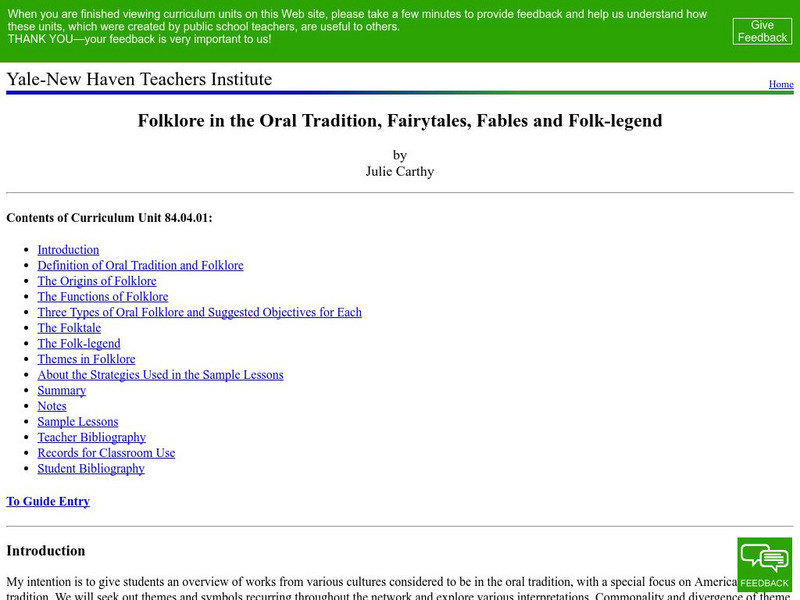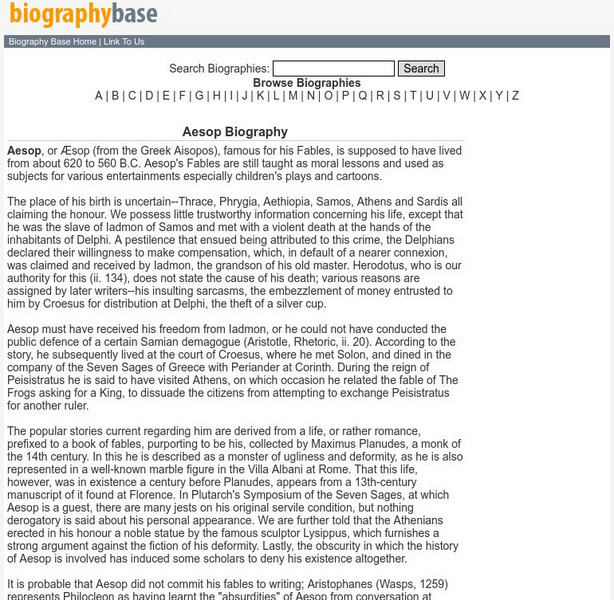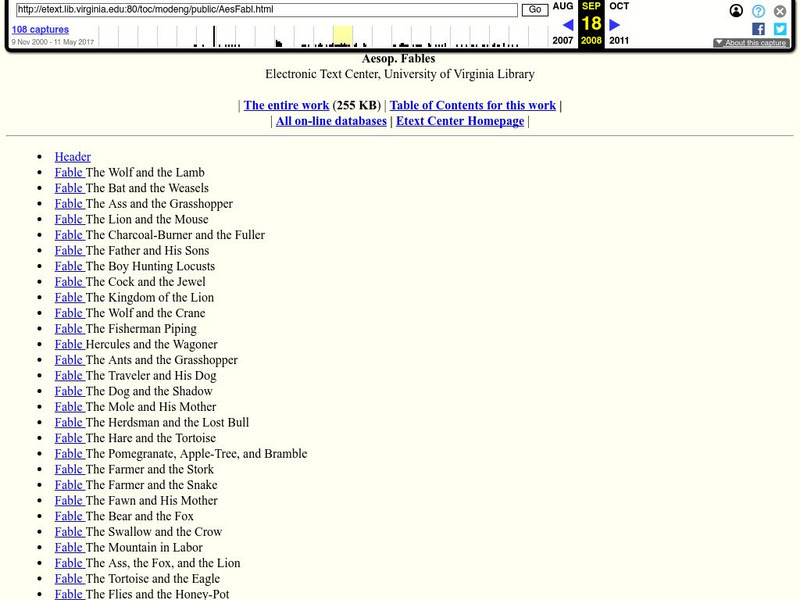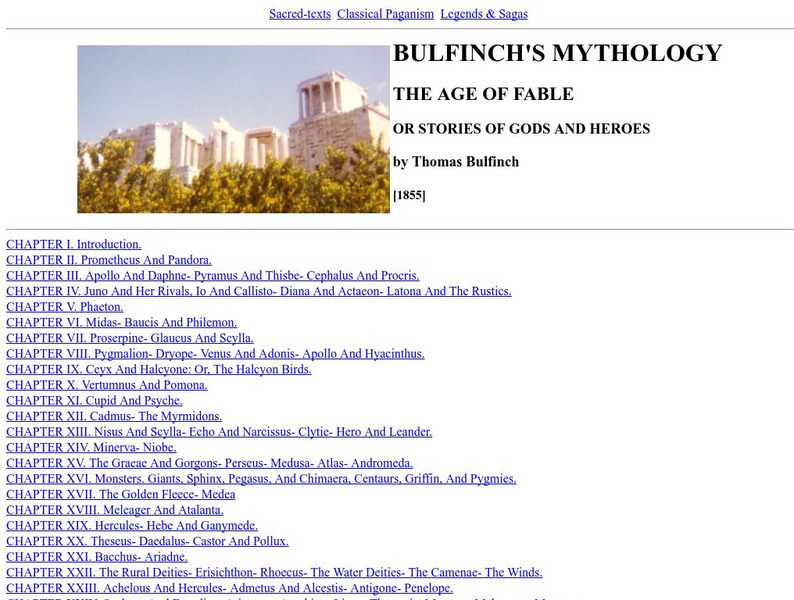Curated OER
Greek culture and Aesop's Fables
Tenth graders explain political and social thought during the Greek 6th and 5th centuries B.C. They research five to eight fables, figuring out the moral for each and writing an essay on how Aesop influenced the morals and ideals of...
Curated OER
Goldilocks and the Three Bears
Students print out the pictures of bears to retell the story of Goldilocks and the Three Bears. In this fable instructional activity, students use the bears to retell the fable story.
Curated OER
J. Paul Getty Museum Education Staff
Learners will examine a manuscript page from a Flemish bestiary and discuss how it was used to teach ideas about Christianity. In this Christianity lesson plan students study the given manuscript and then compare the stories from the...
Curated OER
Fables
In this fables worksheet, students learn about the different parts of a fable. They learn how to retell a story, analyze the characters, identify the moral and dramatize the story.
Curated OER
Fearless Fables: Wee Little Chick And the Magic Apron
In this reading worksheet, students investigate the fable form of storytelling by reading a 3 page fable about a chick who is being bullied. There are no questions on this worksheet.
Curated OER
Fearless Fables: The Moon in Mill Pond
In this reading comprehension worksheet, students participate in reading a fable about some animals who lacked good sense. There are no questions about the story on this page.
Curated OER
Aesop’s Fables Comparison Worksheet
In this Aesop's Fables comparison instructional activity, students list the name of the fable, its characters, a story summary, and the moral of the story. They compare 6 fables.
Curated OER
Recognizing Text Relay
Fifth graders recognize and distinguish between different types of text. After a discussion of the various types of text, small groups compete in a relay race game demonstrating their knowledge of the text. Correct choices earn...
Curated OER
A Story of Giving
Students read a fable and identify their traits and values. They discuss how their family gives to others. They also predict the results of a lifetime of philanthropic giving.
Curated OER
Folktales: Fables
Learners access a variety of resources on the Internet regarding folktales, fables, tall tales, and fairy tales. They read and compare/contrast the elements of fables, and complete various handouts.
Curated OER
Pop Up Fables
Students read a fable and create a pop-up book of the fable. Students add the moral of the story to the back of the book.
Curated OER
Aesop's Fables
Students read a fable about a lion and a mouse. They discuss the differences between the two animals. As a class, they discover the lesson of the story. Then they make puppets and reenact the fable.
Curated OER
Fables With Dolch Sight Words
Second graders read classic fables, consider their meaning and then re-write them using a prompt if necessary. This lesson plan presents many classic fables that students can read, and re-write, using their powers of imagination.
John F. Kennedy Center
The Kennedy Center: Elements of Fables
This ArtsEdge unit on fables shows how to compare and contrast, read and write fables, and discuss the elements they contain. Has great links, definitions, and fable examples.
National Endowment for the Humanities
Neh: Edsit Ement: Animal Fables and Trickster Tales
Animals and tricksters appear in folk tales from a wide variety of cultures, especially those with strong oral storytelling traditions. Use this lesson plan to introduce students to these characters and the lessons they were used to...
Georgia Department of Education
Ga Virtual Learning: Traditions: Book of Wisdom Project [Pdf]
This is a one-page PDF outling a Book of Wisdom project which requires students to write two 300-500 word original fables with all of the characteristics of a fable including a moral or lesson. The second part requires students to find...
Yale University
Yale New Haven Teachers Institute: Definition of Oral Tradition and Folklore
This curriculum unit for teaching about "Folklore in the Oral Tradition, Fairytales, Fables and Folk-legend" begins with a definition of Oral Tradition.
World Wide School
World Wide School: Etext of "Fables"
This site provides the complete etext for Robert Louis Stevenson's "Fables."
Other
Aesop's Fables: Online Collection
In addition to providing full texts of over 600 fables by various authors, this website is a complete source for biographical, historical, and critical information. Many fables include Real Audio narrations so you can listen while you...
Other
Biography Base: Aesop Biography
This is a biography of Aesop, the supposed author of Aesop's Fables, a collection of folktales that use talking animals to teach morals or lessons about life. It also provides of some of his fables.
University of Virginia
University of Virginia: Aesop's Fables
An extensive collection of fables by Aesop in electronic form. An excellent reference from the University of Virginia.
Sacred Text Archive
Internet Sacred Text Archive: Bulfinch's Mythology: The Age of Fable
The text of Bulfinch's Mythology: The Age of Fable or Stories of Gods and Heroes by Thomas Bulfinch, published in 1855.
PBS
Pbs Learning Media: Little Big Mouse
This video segment from Between the Lions features "The Lion and the Mouse" for young students, an introduction to one of many Aesop's fables. illustrates how children can learn by talking about a book as it is read aloud. [4:19]
Better Lesson
Better Lesson: The Fox and the Grapes Moral
Learners will get exposure to a folktale and work to understand the moral. This lesson uses two fables "The Fox and the Grapes" and "The Fox and the Hen". The lesson involves guided practice where the students write notes on the left...













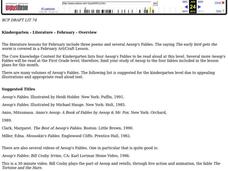


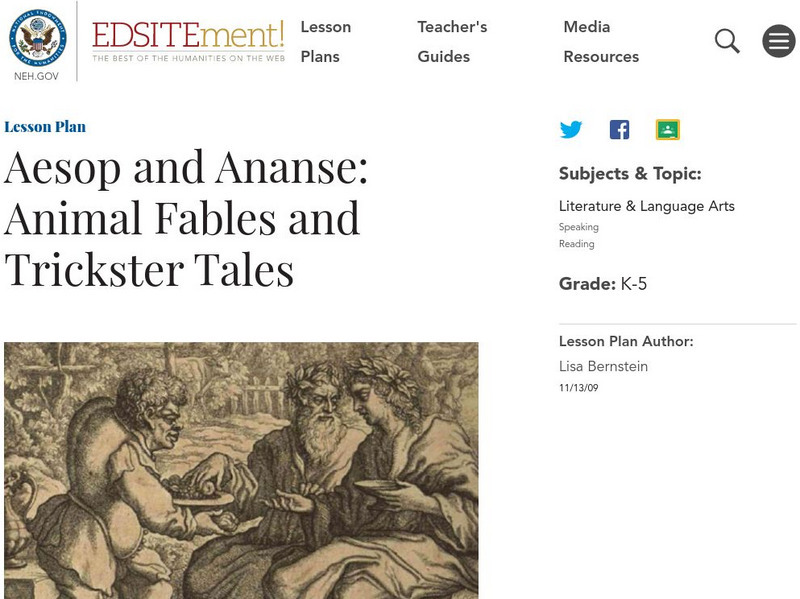
![Ga Virtual Learning: Traditions: Book of Wisdom Project [Pdf] Unknown Type Ga Virtual Learning: Traditions: Book of Wisdom Project [Pdf] Unknown Type](https://d15y2dacu3jp90.cloudfront.net/images/attachment_defaults/resource/large/FPO-knovation.png)
